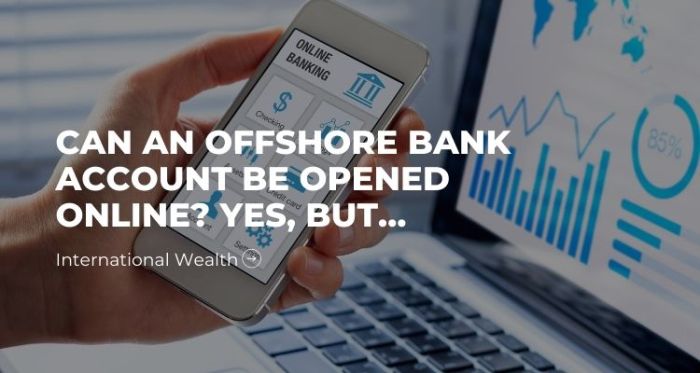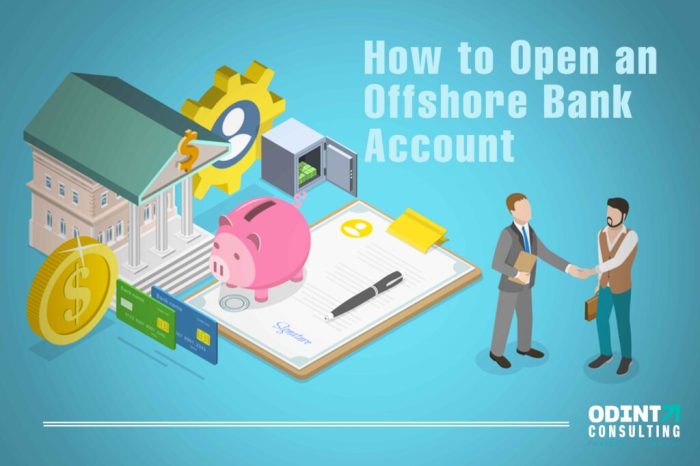How To Open An Offshore Bank Account Online: Navigating the world of offshore banking can feel daunting, but understanding the process can unlock significant financial advantages. This guide demystifies the complexities, providing a clear path to opening an offshore account online, from choosing the right bank and completing the application to managing your account and understanding the tax implications.
We’ll explore the legal landscape, security measures, and best practices to ensure a smooth and secure experience.
Opening an offshore account offers potential benefits like asset protection, diversification, and access to different financial instruments. However, it’s crucial to proceed with caution and due diligence. Understanding the legal and regulatory environment in your chosen jurisdiction is paramount, as is selecting a reputable and trustworthy bank. This comprehensive guide will equip you with the knowledge and steps needed to confidently navigate this process.
Choosing the Right Offshore Bank: How To Open An Offshore Bank Account Online

Opening an offshore bank account requires careful consideration of various factors to ensure security, convenience, and compliance with international regulations. Selecting the wrong institution can lead to significant financial and legal repercussions. This section Artikels key aspects to evaluate when choosing an offshore bank.
Factors to Consider When Selecting an Offshore Bank
Choosing an offshore bank demands thorough due diligence. Key factors include the bank’s reputation, the fees associated with account maintenance and transactions, and the range of services offered. A strong reputation, evidenced by a long operational history and a clean regulatory record, is paramount. High fees can quickly erode account profitability, while limited services might restrict your financial flexibility.
Reputable Offshore Banks: Strengths and Weaknesses
Several offshore banks have established themselves as reputable institutions. However, it’s crucial to understand that “reputable” does not imply risk-free. Each bank has its own strengths and weaknesses, which need to be carefully weighed against individual needs and risk tolerance. For example, a bank known for its robust security measures might have higher fees than one with a less comprehensive security system.
Similarly, a bank offering a wide array of services might have more complex account management procedures. Specific examples of banks and their attributes are omitted here due to the dynamic nature of the financial landscape and the risk of providing potentially outdated information. Always conduct independent research before making a decision.
The Importance of Due Diligence in Selecting a Trustworthy Offshore Banking Institution
Due diligence is not merely a suggestion; it’s a necessity when choosing an offshore bank. This involves thoroughly researching the bank’s history, regulatory compliance, and financial stability. Checking independent reviews and ratings from reputable financial analysis websites can offer valuable insights. Verifying the bank’s licensing and regulatory approvals with the relevant authorities in its jurisdiction is also crucial.
Ignoring due diligence increases the risk of encountering fraudulent institutions or experiencing unforeseen financial complications.
Offshore Bank Comparison
The following table provides a hypothetical comparison of different offshore banks. Remember that fees, minimums, and services are subject to change and this data should not be considered definitive. Always consult the bank’s official website for the most up-to-date information.
| Bank Name | Annual Fee | Minimum Account Balance | Services Offered |
|---|---|---|---|
| Example Bank A | $500 | $50,000 | Online banking, wire transfers, debit card |
| Example Bank B | $1000 | $100,000 | Online banking, wire transfers, debit card, investment services |
| Example Bank C | $250 | $25,000 | Online banking, wire transfers |
| Example Bank D | $750 | $75,000 | Online banking, wire transfers, debit card, credit card, investment services, private banking |
The Online Application Process

Opening an offshore bank account online involves a multi-step process requiring careful attention to detail and accurate documentation. The specific steps and required documents may vary slightly depending on the chosen bank and your jurisdiction, but the general process remains consistent. Understanding this process beforehand can significantly streamline your application.The application process typically involves completing an online form, submitting supporting documentation, and undergoing verification checks.
These checks are crucial for compliance with international anti-money laundering (AML) and know-your-customer (KYC) regulations. Failure to provide accurate and complete information can lead to delays or rejection of your application.
Required Documentation
Offshore banks require comprehensive documentation to verify your identity and the source of your funds. This is a standard procedure designed to prevent financial crimes. Commonly requested documents include a valid passport or national identity card, proof of address (such as a recent utility bill or bank statement), and evidence of the source of funds. The latter might involve bank statements, employment contracts, or investment documentation demonstrating the legitimate origin of your assets.
In some cases, banks may request additional information depending on the amount of money you intend to deposit or the complexity of your financial situation.
Online Application Form Examples and Fields
While the exact format varies across banks, online application forms generally share common fields. A typical form might include sections for personal information (name, address, date of birth, nationality), contact details (phone number, email address), financial information (source of funds, estimated deposit amount), and account details (desired account type, currency). Some forms may also include questions regarding your profession, tax residency, and reasons for opening an offshore account.
For example, one field might ask for your occupation, offering a dropdown menu with various options, while another might require you to upload a scanned copy of your passport’s identification page. Another section might be dedicated to uploading proof of address, requiring a clear image or scan of a recent utility bill.
Step-by-Step Online Application Guide
Before starting, ensure you have all necessary documents readily available in digital format. This will expedite the process.
- Account Selection: Choose the type of account (e.g., personal, corporate) and currency you require from the bank’s website.
- Form Completion: Carefully complete the online application form, providing accurate and up-to-date information in all fields. Double-check for any errors before proceeding.
- Document Upload: Upload clear, legible scans or digital photos of the required supporting documentation, ensuring they meet the bank’s specified requirements regarding file format and size.
- Verification: The bank will review your application and supporting documents. This process can take several days or weeks depending on the bank’s policies and workload.
- Account Activation: Once your application is approved, the bank will activate your account. You will receive confirmation via email or mail, along with instructions on accessing your account online or via other channels.
Security and Fraud Prevention
Opening an offshore bank account online offers numerous benefits, but it’s crucial to prioritize security to protect your assets and personal information. Reputable offshore banks employ robust security measures to safeguard client data and funds, but understanding potential threats and implementing preventative strategies is equally important. This section details the security protocols used by reputable institutions and provides practical advice for mitigating online banking risks.
Reputable offshore banks invest heavily in sophisticated security technologies to protect client data and funds. These measures often include multi-factor authentication (MFA), encryption of all data transmitted between the client and the bank, and rigorous fraud detection systems that monitor transactions for suspicious activity. They also employ advanced firewalls and intrusion detection systems to prevent unauthorized access to their servers.
Furthermore, many offshore banks adhere to strict international regulatory standards, such as those set by the Financial Action Task Force (FATF), further enhancing security protocols.
Online Banking Security Threats and Mitigation Strategies
Online banking, regardless of location, presents inherent security risks. Phishing scams, malware infections, and unauthorized access attempts are common threats. Phishing attacks, for example, involve deceptive emails or websites designed to trick users into revealing their banking credentials. Malware can be installed on a user’s computer to steal sensitive information or control their online activity. Unauthorized access attempts can range from brute-force attacks (repeated attempts to guess passwords) to sophisticated hacking techniques targeting vulnerabilities in the bank’s systems.
Mitigating these risks requires a multi-layered approach. Using strong, unique passwords for each online account is fundamental. Regular software updates, including antivirus and anti-malware software, are essential to protect against malware infections. Being cautious of suspicious emails and websites, verifying the legitimacy of any communication from your bank before clicking on links or providing information, is crucial in preventing phishing attacks.
Furthermore, regularly reviewing your account statements for any unauthorized transactions can help detect fraudulent activity promptly.
Securing Online Banking Credentials and Preventing Phishing
Protecting online banking credentials is paramount. This involves choosing strong, unique passwords that combine uppercase and lowercase letters, numbers, and symbols. Password managers can help securely store and manage multiple passwords. Enabling multi-factor authentication (MFA) adds an extra layer of security, requiring a second form of verification (such as a one-time code sent to your phone) in addition to your password.
Regularly changing your passwords is also a good security practice.
Recognizing and avoiding phishing scams is critical. Legitimate banks will never ask for your password, PIN, or other sensitive information via email or text message. Always verify the sender’s identity by contacting the bank directly through their official website or phone number listed on their official materials. Be wary of suspicious links or attachments in emails, and never click on links from unknown senders.
Hovering your mouse over a link before clicking can reveal the actual URL, helping you identify potentially malicious websites.
Security Tips for Online Offshore Banking
Implementing a comprehensive security strategy is essential for safe online offshore banking. The following tips summarize key preventative measures to enhance your security posture:
- Use strong, unique passwords and a password manager.
- Enable multi-factor authentication (MFA) wherever possible.
- Keep your antivirus and anti-malware software up-to-date.
- Regularly review your account statements for suspicious activity.
- Be wary of suspicious emails and websites; verify the sender’s identity before clicking links or providing information.
- Use a secure internet connection (avoid public Wi-Fi for banking transactions).
- Never share your banking credentials with anyone.
- Report any suspicious activity to your bank immediately.
- Regularly update your operating system and browser software.
- Consider using a virtual private network (VPN) for added security, especially when banking on public Wi-Fi.
Illustrative Examples of Offshore Banking Scenarios
Understanding the practical applications of offshore banking requires examining various scenarios, both successful and challenging. These examples highlight the importance of thorough due diligence, compliance with regulations, and a clear understanding of the tax implications involved.
Successful Offshore Account Opening
This scenario details the experience of Ms. Anya Petrova, a successful entrepreneur based in Russia. Anya needed a more stable and internationally accessible banking solution for her growing import-export business. After researching various options and consulting with a qualified financial advisor, she chose a reputable offshore bank in Singapore known for its robust online platform and transparent regulatory framework.
Anya meticulously prepared all the necessary documentation, including her passport, proof of address, business registration details, and source of funds documentation. She completed the online application form accurately and uploaded all required documents securely through the bank’s portal. The verification process was smooth and efficient; within a week, her account was approved, and she received her account details and online banking access.
Anya then successfully initiated her first international wire transfer from her Russian business account to her new offshore account, seamlessly integrating the offshore account into her financial operations. Key considerations for Anya included choosing a bank with a strong reputation, ensuring complete transparency in her financial dealings, and complying with all relevant reporting requirements in both Russia and Singapore.
Challenges and Risks of Inadequate Due Diligence
Mr. David Lee, a US citizen, attempted to open an offshore account in the British Virgin Islands without proper due diligence. He chose a bank based solely on online advertisements promising exceptionally high interest rates and minimal regulatory scrutiny. He failed to verify the bank’s legitimacy and omitted crucial information on his application, underestimating the importance of thorough documentation. Consequently, his application was flagged for suspicious activity, and the bank rejected his request.
Furthermore, he faced potential legal repercussions due to his failure to comply with US tax reporting regulations regarding foreign accounts. This scenario underscores the risks associated with choosing an offshore bank without proper research and due diligence. The lack of transparency and the potential for fraudulent activities in poorly regulated jurisdictions highlight the critical need for thorough verification of the bank’s reputation and regulatory compliance.
Tax Implications of Offshore Banking
Ms. Sarah Chen, a Canadian citizen, opened an offshore account in Switzerland without fully understanding the tax implications. She believed that simply having an offshore account would automatically shield her income from Canadian taxes. However, she failed to consult a tax advisor specializing in international taxation. Upon filing her taxes, she faced penalties and interest charges due to non-compliance with Canadian tax reporting requirements for foreign accounts.
This scenario emphasizes the crucial role of seeking professional tax advice before opening an offshore account. Understanding the tax treaties between your country of residence and the jurisdiction of the offshore bank is paramount to avoid legal and financial penalties. Proper disclosure and compliance with all reporting requirements are essential to maintain a compliant and transparent financial profile.
International Fund Transfer Visualization, How To Open An Offshore Bank Account Online
Imagine a simple diagram: Box A represents Ms. Anya Petrova’s business account in Russia. Box B represents her newly opened offshore account in Singapore. An arrow labeled “International Wire Transfer” connects Box A to Box B, indicating the flow of funds. Below Box B, another arrow points to Box C, representing a supplier in Germany.
This arrow is labeled “Payment to Supplier”. This visual demonstrates how funds are transferred internationally, using the offshore account as an intermediary for streamlined and efficient international transactions. The entire process is facilitated through the online banking platform of the offshore bank, offering a transparent record of all transactions. The successful transfer demonstrates the efficiency and convenience of using an offshore account for international business operations.
Successfully opening and managing an offshore bank account online requires careful planning and a thorough understanding of the legal and financial landscape. By following the steps Artikeld in this guide, and prioritizing due diligence and security, you can confidently leverage the benefits of offshore banking. Remember, seeking professional financial and legal advice tailored to your specific circumstances is crucial before embarking on this journey.
This ensures compliance and mitigates potential risks, allowing you to navigate the world of offshore finance with confidence and security.

